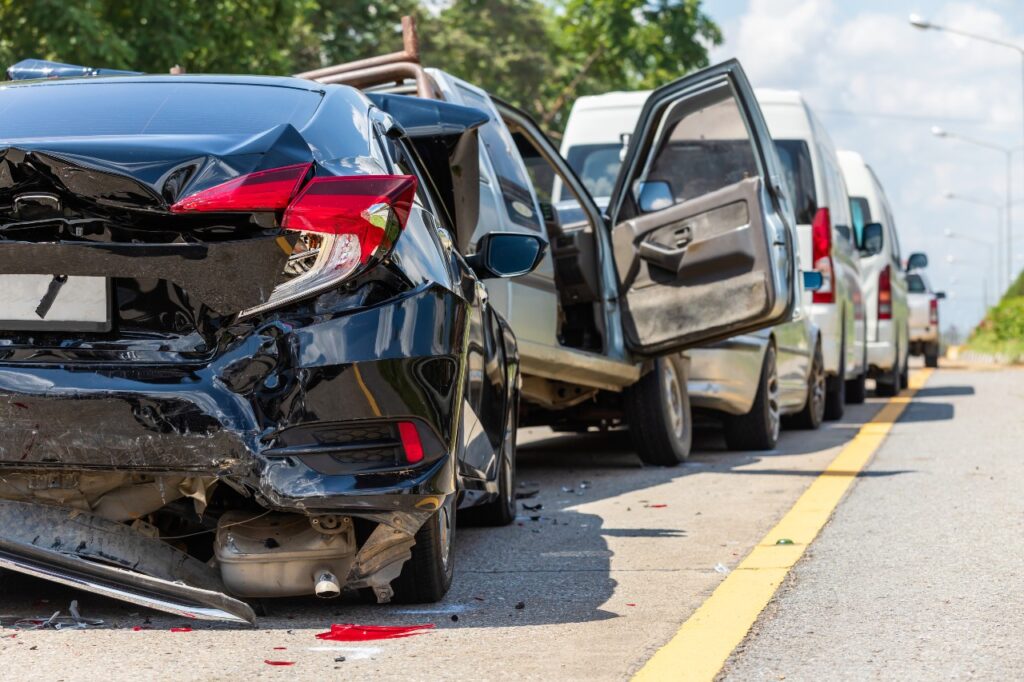If you were rear-ended in California and injured, your first steps are to move to safety, call 911, document the scene (photos, video, witness info), get immediate medical care, file the DMV SR-1 within 10 days if there’s injury or $1,000+ damage, notify your insurer (without giving a recorded statement yet), and Call The Law Offices of Gerald L. Marcus at 818-784-8544 for a free consultation to protect your rights.
Step 1: Get to safety and call 911
-
Move your vehicle out of traffic if it’s safe. Turn on hazards.
-
Call 911. Request police and medical response. A police report locks in critical facts (impact location, parties, witnesses).
-
If symptoms are present (neck pain, headache, dizziness, numbness, back pain), do not refuse medical care on scene. Refusals are often used by insurers to argue your injuries aren’t serious.
Pro tip: If you feel dazed, have ringing in your ears, or can’t remember the moments around impact, tell medics—these can be signs of a concussion.
Step 2: Document the scene like a pro
Evidence evaporates quickly. Gather:
-
Photos/video: Vehicle positions before moving them (if safe), close-ups of damage, skid marks, debris, airbag deployment, road signs, lane markings, and weather/lighting.
-
Injuries: Photograph visible injuries immediately and again over the next 72 hours as bruising evolves.
-
Other driver: License, registration, insurer, policy number.
-
Witnesses: Names, phone numbers, quick voice memo of what they saw (with permission).
-
Event timeline: As soon as you can, type notes about speed, traffic, braking, phone use (yours and theirs), and anything the other driver said (e.g., “I looked down,” “My brakes didn’t work”). Those statements can be admissible.
Step 3: Exchange information and avoid common pitfalls
-
Exchange ID, insurance, and vehicle info.
-
Do not admit fault or argue at the scene. Rear-end crashes are often presumed the trailing driver’s fault, but facts matter (sudden stop, hazard, multi-car chain reaction).
-
Be polite with the officer, keep answers factual and brief.
Step 4: See a doctor within 24–48 hours (even if the ER released you)
Delays in care are the #1 insurer excuse to devalue claims. Get a full evaluation, follow doctor orders, and keep every appointment. Explain all symptoms (neck/back pain, headaches, dizziness, vision issues, sleep problems, anxiety). The chart is the roadmap to your recovery—and to your case.
Track your recovery:
-
Daily symptom journal (pain levels, limitations, missed work).
-
Keep receipts for meds, braces, copays, parking, mileage to appointments.
Step 5: Report the crash properly (California requires it)
California requires that you file a DMV SR-1 within 10 days of a crash that involves any injury or death or property damage over $1,000. Your insurance agent or lawyer can file it for you. Failing to file can trigger license/registration issues.
You should also notify your own insurer promptly (most policies require it), but do not agree to a recorded statement for any insurer before you’ve spoken with a lawyer.
Step 6: Don’t give recorded statements (yet)
Insurance adjusters are trained to minimize claims. They’ll push for early recorded statements and medical authorizations. Politely decline until you have legal representation. Early statements—especially when you’re in pain or on medication—often get twisted against you.
Step 7: Preserve physical and digital evidence
-
Keep your car until it’s inspected and photographed. Don’t rush to repair or total without documenting damage thoroughly.
-
Download dash-cam footage, if any.
-
Save phone data (texts with the other driver/insurer, ride-share receipts if applicable, GPS logs).
-
Work proof: Timesheets, pay stubs, tax returns for lost earnings or lost earning capacity.
Step 8: Understand California law that affects your claim
Statute of limitations (SOL):
-
Personal injury: Generally 2 years from the date of injury to file suit.
-
Property damage: Generally 3 years from the date of damage.
-
Claims against government entities (e.g., city bus, poorly maintained roadway): You must file an administrative claim within 6 months before you can sue. Miss it and your case could be barred.
Comparative negligence:
California is a pure comparative negligence state. If the insurance company says you were 20% at fault (e.g., not wearing a seatbelt or following too closely before being rear-ended in a chain reaction), your compensation may be reduced by that percentage—but you can still recover.
Mandatory reporting to DMV:
As noted, file the SR-1 within 10 days for injury/death or $1,000+ property damage.
Step 9: See the doctor to completion—and follow the plan
Insurers scrutinize gaps in treatment and “noncompliance.” If you need referrals (orthopedist, neurologist, pain management, physical therapy, chiropractic, imaging), get them promptly. If cost is an issue, we can help arrange care with providers who accept liens, so you pay nothing upfront.
Step 10: How The Law Offices of Gerald L. Marcus strengthens your case
We take over immediately so you can heal:
-
Stop harassing calls: We handle the insurers.
-
Protect your statements: We speak for you.
-
Build evidence: We secure footage, inspect vehicles, download EDR (“black box”) data, and obtain scene/traffic-signal timing where relevant.
-
Prove fault: Rear-end liability often looks simple, but multi-car or commercial-truck impacts require accident reconstruction and biomechanics to quantify delta-V (change in speed) and forces on your spine.
-
Prove damages: We collect medical records, expert narratives, work loss proofs, and life-impact documentation to present the full story.
Results-driven negotiation: We develop a settlement package that anticipates how a jury would see your case—pushing the carrier to pay full value or face trial.
No fee unless we win. You pay nothing upfront for our time or case costs. We cover investigation, records, experts—everything needed to position your case for maximum value.
Statewide representation: From Los Angeles County to San Diego, Orange County, the Inland Empire, Ventura, Santa Barbara, the Central Valley, the Bay Area, and beyond—we come to you if you can’t travel.
Call 818-784-8544 or live chat/text us for a free case evaluation with an experienced California car accident lawyer.
What compensation can you recover after a rear-end crash?
Depending on the facts and coverage available, you may recover:
-
Medical expenses (ER, imaging, specialists, therapy, surgery)
-
Future medical care (injections, surgery, pain management)
-
Lost wages and loss of earning capacity
-
Property damage (repair/total loss, diminished value, rental)
-
Out-of-pocket expenses (mileage, meds, devices)
-
Pain, suffering, and emotional distress
-
Scarring/disfigurement and loss of enjoyment
-
Punitive damages (rare; only for egregious misconduct like DUI)
Insurance coverage that may apply
-
At-fault driver’s liability (bodily injury, property damage)
-
Your Med-Pay (no-fault medical benefits regardless of fault)
-
Your Uninsured/Underinsured Motorist (UM/UIM) (if the at-fault driver has low or no insurance)
-
Employer policies (if you were on the job)
-
Rideshare coverage (special coverage periods apply if you were an Uber/Lyft driver or passenger)
Important: Coverage rules can be complex; our team identifies every policy and stacks coverages where possible to maximize recovery.
Rear-end crashes: common defenses and how we counter them
-
“Low-impact = no injury.”
False. Medical literature shows that even low-speed impacts can cause significant soft-tissue and spinal injuries. We use imaging, treating-doctor narratives, and biomechanics to prove it. -
“Pre-existing condition.”
California law compensates aggravation of prior injuries. We obtain prior records to show the “before and after.” -
“Delay in treatment.”
We connect your symptoms to the crash timeline and explain gaps (transportation, childcare, cost, work constraints) through your treating providers. -
“You were partly at fault.”
In chain-reaction or sudden-stop scenarios, we analyze scene evidence, vehicle crush, and timing to apportion fault correctly under pure comparative negligence.
Special situations
-
Government vehicles/road defects: Six-month government claim deadline. Do not wait.
-
Commercial trucks: Preserve ELD logs, driver qualification files, maintenance records. We send litigation holds early.
-
Rideshare (Uber/Lyft): Coverage depends on “app on” status and whether a ride was accepted.
-
Hit-and-run: Report promptly; your UM coverage may step in.
-
Unlicensed/uninsured at-fault driver: UM/UIM and Med-Pay become critical.
The “Do Not” list (save your claim)
-
Don’t post about the crash or your injuries on social media.
-
Don’t skip or stop treatment early.
-
Don’t accept quick cash offers before you know the full diagnosis and future care needs.
-
Don’t give recorded statements or blanket medical authorizations.
-
Don’t repair/total your car before capturing high-quality damage images and estimates.
FAQs: Rear-ended in California
Do I have to report the crash to the DMV?
Yes—file the SR-1 within 10 days if anyone was injured or if property damage exceeded $1,000.
How long do I have to file a lawsuit?
Generally 2 years for injury and 3 years for property damage. Some claims (government entities) require action in 6 months. Talk to a lawyer immediately to avoid missing deadlines.
What if I might be partly at fault?
You can still recover under pure comparative negligence; your award may be reduced by your percentage of fault. Legal Information Institute
Should I see a doctor even if I “feel fine”?
Yes. Symptoms often surface hours or days later. Early documentation is critical for your health and claim.
How much is my case worth?
It depends on injuries, treatment, long-term effects, fault, and available insurance. We’ll evaluate all factors free of charge.
Call The Law Offices of Gerald L. Marcus Right Now 
Injured in a rear-end crash anywhere in California?
Call 818-784-8544 or live chat/text us now. We’ll protect your rights, handle the insurance companies, and fight to maximize your recovery.
You pay nothing upfront—and nothing unless we win.


 We Don’t Back Down. We Dominate. Over $450 Million Won for Injury Victims.
We Don’t Back Down. We Dominate. Over $450 Million Won for Injury Victims.
